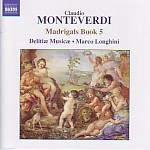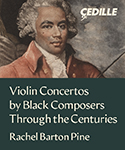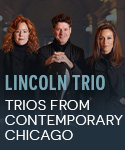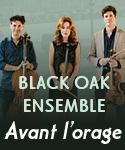The works in Monteverdi’s Fifth Book of Madrigals are far from the “fa la la” and “hey noney noney” ditties that you might have sung in your high school chamber choir. They require a huge vocal range, perfect tuning and intonation, and tremendous stamina. Most of them, not surprisingly, describe the pain and suffering arising from love lost, spurned, rejected, absent, or otherwise less than ideally returned. The very first number, Cruda Amarilli, contains chromaticisms and dissonances that would have made Gesualdo proud, but historically speaking the revolutionary character of this set largely concerns the last six items, which employ a full basso continuo and so form a link to music of the emergent Baroque period. The concluding piece, Questi vaghi concenti, actually is a vocal concerto for double choir (eight parts) and instruments that lasts nearly 10 minutes, and it makes a truly grand finale.
Ironically, these more “advanced” items might strike today’s listeners as less challenging because this kind of sound is still very much with us. The use of the continuo permits Monteverdi to create little dramatic scenes consisting of solos, duos, and trios, rather than the fuller five-part texture of the remaining works. This brings each piece a bit closer to the modern notion of the operatic aria, or song, and indeed the landmark opera Orfeo was just around the corner when the Fifth Book was published in 1605. So you may very well find such stylistically traditional pieces as Era l’anima mia even more arresting on account of its vocal “orchestration” and for the exceptional range of texture Monteverdi gets from contrasting homophonic, polyphonic, and parlando (almost speaking) passages. In short, this is an extraordinarily varied collection despite the expected emphasis on emotions of sadness and despair.
My colleague David Vernier heaped praise on Delitiae Musicae’s recordings of Books 2 and 3, and this newcomer is no less satisfying. According to conductor Marco Longhini, modern research suggests that all-male ensembles performed these pieces, a reasonable surmise given the large number of high-voiced male church choristers who needed to make a living, and who must have performed secular music as well. In any case, Monteverdi never would have limited his options by ruling out any legitimate performance possibility. More to the point, the singing here is superb–characterful and expressive in a way that often happens when singers are working with their native language. The basses in particular put an impressively firm bottom on the ensemble, and the two countertenors never sound strained or “hooty”. A lovely selection of plucked and strummed continuo instruments adds an additional layer of color to the proceedings, and the sonics capture it all with glowing realism. Perhaps Naxos will find a similarly adroit group to tackle a comprehensive series of English madrigals, a genre strangely lacking in catalog representation at present. [7/19/2006]
































